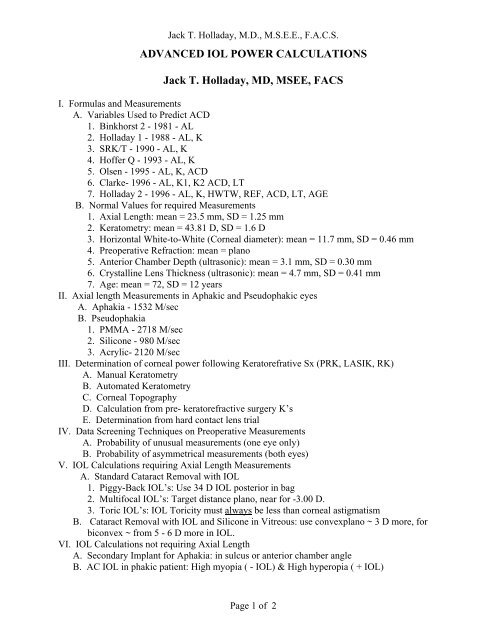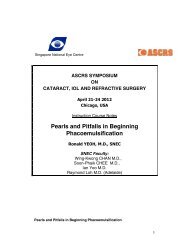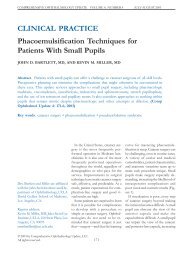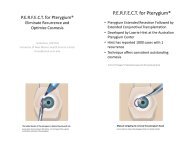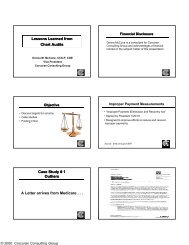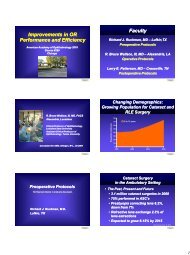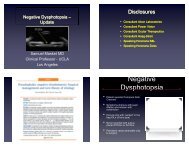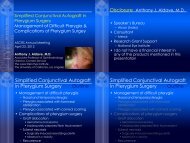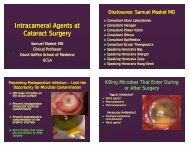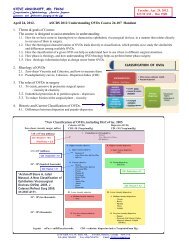ADVANCED IOL POWER CALCULATIONS Jack T ... - ascrs 2012
ADVANCED IOL POWER CALCULATIONS Jack T ... - ascrs 2012
ADVANCED IOL POWER CALCULATIONS Jack T ... - ascrs 2012
Create successful ePaper yourself
Turn your PDF publications into a flip-book with our unique Google optimized e-Paper software.
<strong>Jack</strong> T. Holladay, M.D., M.S.E.E., F.A.C.S.<strong>ADVANCED</strong> <strong>IOL</strong> <strong>POWER</strong> <strong>CALCULATIONS</strong><strong>Jack</strong> T. Holladay, MD, MSEE, FACSI. Formulas and MeasurementsA. Variables Used to Predict ACD1. Binkhorst 2 - 1981 - AL2. Holladay 1 - 1988 - AL, K3. SRK/T - 1990 - AL, K4. Hoffer Q - 1993 - AL, K5. Olsen - 1995 - AL, K, ACD6. Clarke- 1996 - AL, K1, K2 ACD, LT7. Holladay 2 - 1996 - AL, K, HWTW, REF, ACD, LT, AGEB. Normal Values for required Measurements1. Axial Length: mean = 23.5 mm, SD = 1.25 mm2. Keratometry: mean = 43.81 D, SD = 1.6 D3. Horizontal White-to-White (Corneal diameter): mean = 11.7 mm, SD = 0.46 mm4. Preoperative Refraction: mean = plano5. Anterior Chamber Depth (ultrasonic): mean = 3.1 mm, SD = 0.30 mm6. Crystalline Lens Thickness (ultrasonic): mean = 4.7 mm, SD = 0.41 mm7. Age: mean = 72, SD = 12 yearsII. Axial length Measurements in Aphakic and Pseudophakic eyesA. Aphakia - 1532 M/secB. Pseudophakia1. PMMA - 2718 M/sec2. Silicone - 980 M/sec3. Acrylic- 2120 M/secIII. Determination of corneal power following Keratorefrative Sx (PRK, LASIK, RK)A. Manual KeratometryB. Automated KeratometryC. Corneal TopographyD. Calculation from pre- keratorefractive surgery K’sE. Determination from hard contact lens trialIV. Data Screening Techniques on Preoperative MeasurementsA. Probability of unusual measurements (one eye only)B. Probability of asymmetrical measurements (both eyes)V. <strong>IOL</strong> Calculations requiring Axial Length MeasurementsA. Standard Cataract Removal with <strong>IOL</strong>1. Piggy-Back <strong>IOL</strong>’s: Use 34 D <strong>IOL</strong> posterior in bag2. Multifocal <strong>IOL</strong>’s: Target distance plano, near for -3.00 D.3. Toric <strong>IOL</strong>’s: <strong>IOL</strong> Toricity must always be less than corneal astigmatismB. Cataract Removal with <strong>IOL</strong> and Silicone in Vitreous: use convexplano ~ 3 D more, forbiconvex ~ from 5 - 6 D more in <strong>IOL</strong>.VI. <strong>IOL</strong> Calculations not requiring Axial LengthA. Secondary Implant for Aphakia: in sulcus or anterior chamber angleB. AC <strong>IOL</strong> in phakic patient: High myopia ( - <strong>IOL</strong>) & High hyperopia ( + <strong>IOL</strong>)Page 1 of 2
<strong>Jack</strong> T. Holladay, M.D., M.S.E.E., F.A.C.S.C. Secondary Piggy-Back <strong>IOL</strong> for high hyperopia (or myopia within 1 year)VII. Pediatric <strong>IOL</strong> calculationsA. Ideal Postoperative Target Refraction: plano to -1.00 D.B. Expected Myopic Shift with age: 4 D from age 2 to age 21.VIII. Minimizing Prediction ErrorA. Personalizing Formula Constants (A-const, ACD or Surgeon Factor)B. Prediction Error vs. <strong>IOL</strong> PowerC. Creating personalized constants for subgroups1. Axial Length (< 22 mm or > 26 mm)2. Keratometry (< 40 D or > 48 D)3. Preoperative Refraction (< -4 D or > +4 D)IX. Calculating SIRC (Surgically induced refractive change)A. From pre and post operative keratometryB. From pre and post operative refractionX. Outcomes AnalysisA. Prediction Error Analysis: Mean absolute prediction error should be < 0.50 D.B. Formula Comparisons: more predictors, better results in unusual eyesC. SIRC Results: Astigmatic AnalysisD. Visual Acuity Results1. Best corrected2. UncorrectedXI. Back-calculationsA. For determining source of error with refractive surpriseB. Comparison of back-calculated lens constant and actual lens constantPage 2 of 2
<strong>ADVANCED</strong> <strong>IOL</strong> <strong>CALCULATIONS</strong> <strong>2012</strong>Advanced<strong>IOL</strong> Power Calculations<strong>Jack</strong> T. Holladay, MD, MSEE, FACSClinical Professor of OphthalmologyBaylor College of MedicineHouston, Texas, USAFinancial Disclosure• I have the following financial interests orrelationships to disclose:• Acufocus ® –Consultant• Allergan® – Consultant• AMO ® –Consultant• NIDEK ® –Consultant• Oculus ® –Consultant• Wavetec ® –Consultant• Zeiss ® –Consultant<strong>Jack</strong> T. Holladay, MD, MSEE, FACSwww.docholladay.comClinical Professor of OphthalmologyBaylor College of MedicineHouston, TexasFax: 713 668 7336www.docholladay.com7Vergence Formulawww.docholladay.com7• Theoretical Formula has notchanged in 100 years• Physiologic Assumptionsmay be slightly different• Retinal thickness• Corneal Index of RefractionJACK T. HOLLADAY, MD, MSEE, FACS Page 1 of 19
<strong>ADVANCED</strong> <strong>IOL</strong> <strong>CALCULATIONS</strong> <strong>2012</strong>Vergence Formula1336 1336<strong>IOL</strong>ALELP1336ELP1000K1000DPostRx VE L PEffective Lens Position• Distance from cornealvertex to principal plane ofthin <strong>IOL</strong> (no thickness)• Same as ACD, but avoidsconfusion with anatomyPrediction of E L P 26 mm35 eyes = normalJACK T. HOLLADAY, MD, MSEE, FACS Page 2 of 19
<strong>ADVANCED</strong> <strong>IOL</strong> <strong>CALCULATIONS</strong> <strong>2012</strong>Measurements taken forPredictors of ELP Axial Length Average K Horizontal WTW ACD LT Pre-opRefraction AgeHWTW GaugeHorizontal Corneal DiameterASICO # AE ASICO # AE Normal EyesShort Eyes ( < 21 mm)100080# of Ca ases8006004002000N = 82496%2% 2%Small Normal LargeAnterior Segment Size# of Ca ases604020080%N = 9320%0%Small Normal LargeAnterior Segment SizeJACK T. HOLLADAY, MD, MSEE, FACS Page 3 of 19
<strong>ADVANCED</strong> <strong>IOL</strong> <strong>CALCULATIONS</strong> <strong>2012</strong>Long Eyes ( > 27 mm)Normal Physiologic Values# of Ca ases806040200N = 16290%0%10%Small Normal LargeAnterior Segment Size• Al: 23.5 mm+ 1.25 mm• K: 43.81 D +1.6 D• Hwtw: 11.7 mm+ 0.46 mm• Ref: -0.60 D + 2.00 DNormal Physiologic Values• ACD: 3.1 mm• LT: 4.7 mm• Age: 72 years+ 0.30 mm+ 0.41 mm+ 12.0 yearsCritical Data• Corneal Power• “Optical” Axial Length• Horizontal “White White-toto-WhiteWhite”(11 (11.7)• AC angle = WTW + 1.0 (12.7)• Sulcus = WTW + 1.5 (13.2)• Bag = WTW – 1.0 (10.7)CONCLUSIONEye Model must includeNINEtypes of eyes not onlyTHREEment SizeAnterior SegLargeCONCLUSION: 9 EYESMegalocornea+ axial MegalocorneahyperopiaLarge EyeBuphthalmosMegalocornea+ axial myopia(10%)axial a myopia yopa(90%)(0%)(2%)Normalaxial a hyperopia opa normal axial a myopia yopa(80%) (96%) (90%)SmallSmall eyeNanophthalmia Microcornea(20%) (2%)Short NormalLongAxial LengthMicrocornea+ axial opia(0%)JACK T. HOLLADAY, MD, MSEE, FACS Page 4 of 19
<strong>ADVANCED</strong> <strong>IOL</strong> <strong>CALCULATIONS</strong> <strong>2012</strong>Relative Importance ofPredictors for ELP Axial Length 100 Average K 76 Horizontal WTW 24 Refraction 18 ACD 8 LT 7 Age 1THE HOLLADAY 2 FORMULAMore MeasurementsMore AccuracyFORMULA PERFORMANCECONCLUSIONSMean AbsoluteError (D)654N = 997321015 20 25 30Axial Length (mm)Holladay 1Hoffer QSRK/THolladay 2• Prediction Errors in Short Eyes:significantly improved by moremeasurements• Prediction Errors in Long Eyes:due to bad Axial Lengths, B-ScanMyopic StaphylomaJACK T. HOLLADAY, MD, MSEE, FACS Page 5 of 19
<strong>ADVANCED</strong> <strong>IOL</strong> <strong>CALCULATIONS</strong> <strong>2012</strong>Zeiss-Humphrey <strong>IOL</strong> MasterSubtractfrom AscanmeasuredAilL Axial Length~ 0.8 mmZaldivar-Holladay JCRS May 2000Zeiss-<strong>IOL</strong> Master - 2000Difficult CasesAsteroid Hyalosis (vit. debris)Extreme Length (26.5 mm)Extreme Short (< 21 mm)Pseudophakic EyesSilicone in VitreousCataract Surgery …<strong>IOL</strong> Power CalculationsFollowing RefractiveSurgeryPreoperative Assessment• Endothelial Cell Count• Pachymetry• Direct Ophthalmoscope @ 16”• Corneal Topography• Determining Corneal Power• <strong>IOL</strong> CalculationJACK T. HOLLADAY, MD, MSEE, FACS Page 6 of 19
<strong>ADVANCED</strong> <strong>IOL</strong> <strong>CALCULATIONS</strong> <strong>2012</strong>Corneal Power afterLASIK, PRK, RK Ideally, Calculation from bothsurfaces … Calculation from Prior Data Trial Hard Contact Lens Corneal Topography Automated Keratometry Manual KeratometryPachymetry andPosteriorCorneal SurfaceNew patentedlaser cross formeasurement ofposterior cornealsurface and opticalpachymentry4 mm OZ with 6 cuts ~~ - 4.00 DJACK T. HOLLADAY, MD, MSEE, FACS Page 7 of 19
<strong>ADVANCED</strong> <strong>IOL</strong> <strong>CALCULATIONS</strong> <strong>2012</strong>3 mm pinholeRigid Contact LensTrial Frame1. Calculation from Prior Data(Pre K & Δ MR known)Pre KR Mean K= 44.00 DChange in SEQ Ref = -4.50 DCalc Mean K = 39.50 DJACK T. HOLLADAY, MD, MSEE, FACS Page 8 of 19
<strong>ADVANCED</strong> <strong>IOL</strong> <strong>CALCULATIONS</strong> <strong>2012</strong>2. Calculation from Prior Data(Post Std. K’s & Δ MR only)Post Mean K= 40.58 DChange in SEQ Ref = -4.50 450DSTD K’s: -0.24* SEQ = -1.083. Calculation from Prior Data(Post Ctr Top Power & Δ MR only)Post Mean K= 40.27 DChange in SEQ Ref = -4.50 450DCtr Top: -0.15* SEQ = -0.77Calc Mean K = 39.50 DCalc Mean K= 39.50 D4. Trial Hard Contact Lens(Rigid Contact lens only)Plano HCL Base CurveSEQ Ref without CLSEQ Ref with CL= 41.50 D= +0.50 D= -1.00 DFront K = 41.50 - 1.50 = 40.00 D40.00 D – 10% (4.50) = 39.50 DMean K= 39.50 DPost-operative• Initial Hyperopic Shift• Long Term Hyperopic Drift• ATR Astigmatism DriftJACK T. HOLLADAY, MD, MSEE, FACS Page 9 of 19
<strong>ADVANCED</strong> <strong>IOL</strong> <strong>CALCULATIONS</strong> <strong>2012</strong>Accuracy of EKRPriorSxLASIKSTD 4.5(D)0.56LASIK 0.56RK 0.94Holladay JT, Hill WE, Steinmueller A. Corneal PowerMeasurements Using Scheimpfl ug Imaging in Eyes With PriorCorneal Refractive Surgery. J Refractive Surgery 2009:25:862-868. (October 2009 Issue of J Refr Surgery)JACK T. HOLLADAY, MD, MSEE, FACS Page 10 of 19
<strong>ADVANCED</strong> <strong>IOL</strong> <strong>CALCULATIONS</strong> <strong>2012</strong>Holladay ReportEquivalent Keratometric PowerJACK T. HOLLADAY, MD, MSEE, FACS Page 11 of 19
<strong>ADVANCED</strong> <strong>IOL</strong> <strong>CALCULATIONS</strong> <strong>2012</strong>Normal LASIK RK41 to 44 D3 D Range36 to 41 D5 D Range32 to 45 D13 D RangeSummary• Optimal Zone• LASIK: 4.5 mm• RK: 5.0 mm• Customize for small/large pupilspils• Accuracy• LASIK: ± 0.56 D• RK: ± 0.94 D• Error on MYOPIC side<strong>IOL</strong> Calcs Using Axial LengthAxial Length Measurements• Cataract or Clear Lens Removal• Primary Piggy-Back <strong>IOL</strong>’s• Multifocal <strong>IOL</strong>’s• Toric <strong>IOL</strong>’s• Silicone in Vitreous Compartment• Phakia• Aphakia• Pseudophakia• PMMA• Silicone• AcrylicAL 1555ALAL 1532AL 1532 + 0.4AL 1532 - 0.6AL 1532 + 0.2Primary Piggy-Back <strong>IOL</strong>’sPrimary PIGGY-BACKINTRAOCULAR LENSES• Current Formulas are veryinaccurate• ELP underestimated due to AL• Back lens displaced posteriorly• Severe hyperopic errors (+5 D)JACK T. HOLLADAY, MD, MSEE, FACS Page 12 of 19
<strong>ADVANCED</strong> <strong>IOL</strong> <strong>CALCULATIONS</strong> <strong>2012</strong>PolypseudophakiaUp to 4 <strong>IOL</strong>’sPIGGY-BACKINTRAOCULAR LENSESJ.T. HolladayJane LeidleinJames P. GillsMyra Cherchio“Achieving Emmetropia In Extremely ShortEyes With Two Piggy-Back PosteriorChamber Intraocular Lenses.”Ophthalmology Journal. Vol. 103.July 1996 Blue Journal”Primary PIGGY-BACKINTRAOCULAR LENSES• Loop haptic <strong>IOL</strong>’s• Always align haptics• Haptics Horizontal (3 & 9)• Plate haptic <strong>IOL</strong>’s• Perpendicular• Axis @ 45º & 135ºPrimary Piggy-BackComplicationsAcrylicInterlenticular membrane3 to 5 D hyperopic shift @ 3 yrSiliconeInterlenticular membraneFlat SpotJACK T. HOLLADAY, MD, MSEE, FACS Page 13 of 19
<strong>ADVANCED</strong> <strong>IOL</strong> <strong>CALCULATIONS</strong> <strong>2012</strong>Complications• Induced Astigmatism forLens Tilt of 20 D <strong>IOL</strong>• 10º 0.5 D• 20º 2.0 D• 30º 5.0 D• Lens Decentration 0.5 mm• Axial Misplacement 0.5 mmComplications• Axial Misplacement of 1.0 mm• 10 D 1.0 D• 20 D 2.0 D• 40 D 4.0 D• 60 D 6.0 DMinimizing Prediction Error• Holladay 2 Formula• Personalize Constant• Prediction Error vs. <strong>IOL</strong> power• Constants for Sub-groups• Axial Length, K’s and RefractionMultifocal <strong>IOL</strong>’s• Calculate required <strong>IOL</strong> forboth distance (plano) andnear (-3.00)• Difference in <strong>IOL</strong> powers isthe add required on <strong>IOL</strong>( See Array Calc 05)JACK T. HOLLADAY, MD, MSEE, FACS Page 14 of 19
<strong>ADVANCED</strong> <strong>IOL</strong> <strong>CALCULATIONS</strong> <strong>2012</strong>Multifocal <strong>IOL</strong>’s<strong>IOL</strong> for distance = 22.31 D<strong>IOL</strong> for near = 26.75 D<strong>IOL</strong> Add = 4.44 DChoose nearest available Add(22.5 D with 4.5 D Add)Multifocal <strong>IOL</strong> Target• Plano to slightly hyperopic (+0.1to +0.3)• Rarely myopic unless specializenear requirement for near work• Ask patient for near distancepreference and look at presentbifocals or trifocalsArray Multifocal <strong>IOL</strong>Add• 2.6 D @ SpectaclePlane• 3.8 D @ <strong>IOL</strong> PlaneToric <strong>IOL</strong>’s• Current Formulas do notwork because calculatedifferent ELP for steep andflat meridian• Predicted ELP must be thesame for each meridian --only one <strong>IOL</strong> positionToric <strong>IOL</strong>’s• Correcting Astigmatismwith <strong>IOL</strong>• <strong>IOL</strong> Astig = 1.41 * Corneal Astig• Ex. Cornea = 1 D of astig<strong>IOL</strong> = 1.41 D of astig tocorrectRatio = 1.41 for 22 D <strong>IOL</strong>, A=118{1.20 to 1.75 ( <strong>IOL</strong> or A)}Toric <strong>IOL</strong>’s• Calculate <strong>IOL</strong> power forsteep and flat meridianusing same ELP• Difference in <strong>IOL</strong> powers isthe toricity necessary tocompletely correct cornealastigmatismJACK T. HOLLADAY, MD, MSEE, FACS Page 15 of 19
<strong>ADVANCED</strong> <strong>IOL</strong> <strong>CALCULATIONS</strong> <strong>2012</strong>Toric <strong>IOL</strong>’s• Always choose toricity toundercorrect cornealastigmatism• Eg: Steep calc yields 24.0 DFlat calc yields27.0 D• Ideal Toricity is 3.0 D(Use 24.0 D with < 3.0 D of toricity)OptimizerMean Dev = -0.72 DJACK T. HOLLADAY, MD, MSEE, FACS Page 16 of 19
<strong>ADVANCED</strong> <strong>IOL</strong> <strong>CALCULATIONS</strong> <strong>2012</strong>Silicone in Vitreous Cavity• Use Convexo-Plano<strong>IOL</strong> tominimize effect of Silicone(add 3 D to calculated <strong>IOL</strong>)• If Biconvex <strong>IOL</strong>(add 6 D to calculated <strong>IOL</strong>)• When Silicone removed -- 2to 5 D of induced myopia<strong>IOL</strong> Calculationsusing aRefractive Formula(ignore axial length)<strong>IOL</strong> Calculation without ALREFRACTION FORMULA• Secondary AC or PC <strong>IOL</strong> forAphakia• Secondary Piggy-Back AC orPC <strong>IOL</strong> for Pseudophakia• Primary AC <strong>IOL</strong> in Phakia<strong>IOL</strong>13361336ELP1000 K1000PreRx V13361336ELP1000 K1000DPostRx VSecondary Piggy-Back <strong>IOL</strong>’sIndicationsIntolerable PseudophakicRefractive ErrorRefractive Surprises Previous RK, PRK, LASIK Bad axial length - short/long Mislabeled <strong>IOL</strong> Axially displaced Misc.JACK T. HOLLADAY, MD, MSEE, FACS Page 17 of 19
<strong>ADVANCED</strong> <strong>IOL</strong> <strong>CALCULATIONS</strong> <strong>2012</strong>Secondary Piggy-Back CalcAdvantages over Exchange Mislabeled <strong>IOL</strong> irrelevant Less risk to capsule or zonules Mismeasured AL irrelevant No AP shift of existing <strong>IOL</strong> Fewer unknown variablesPhakic <strong>IOL</strong> Calculations• Angle supported <strong>IOL</strong>• Calculations accurate• Iris supported <strong>IOL</strong>• Calculations accurate• ICL’sPediatric <strong>IOL</strong> Calculations• Ideal Refraction: plano to -1 D• Expect average of 4 D myopicshift from age 2 to 20• Much easier to correct myopiaat age 20 than amblyopiaMinimizing Prediction Error• Holladay 2 Formula• Personalize Constant• Prediction Error vs. <strong>IOL</strong> power• Constants for Sub-groups• Axial Length, K’s and RefractionJACK T. HOLLADAY, MD, MSEE, FACS Page 18 of 19
<strong>ADVANCED</strong> <strong>IOL</strong> <strong>CALCULATIONS</strong> <strong>2012</strong>Surgically InducedRefractive ChangeSIRC• From Keratometry• Cataract & Clear Lensectomy• Keratorefractive Sx.• From Refraction• Keratorefractive Sx.Outcome Analysis• Prediction Error (50% < 0.50 D)• Formula Comparisons• Induced Astigmastism (SIRC)• Visual Acuity• Best Corrected• UncorrectedBack-CalculationsThank you !• Helpful in determining causeof refractive surprise• Back-calculated calculated K, AL and <strong>IOL</strong>power compared to pre-op & topost-op op remeasured values• Back-calculated calculated ELP comparedto preoperative prediction byformulaSydney• • • • The International Society of Refractive Surgery • • • •April 23,2002JACK T. HOLLADAY, MD, MSEE, FACS Page 19 of 19


